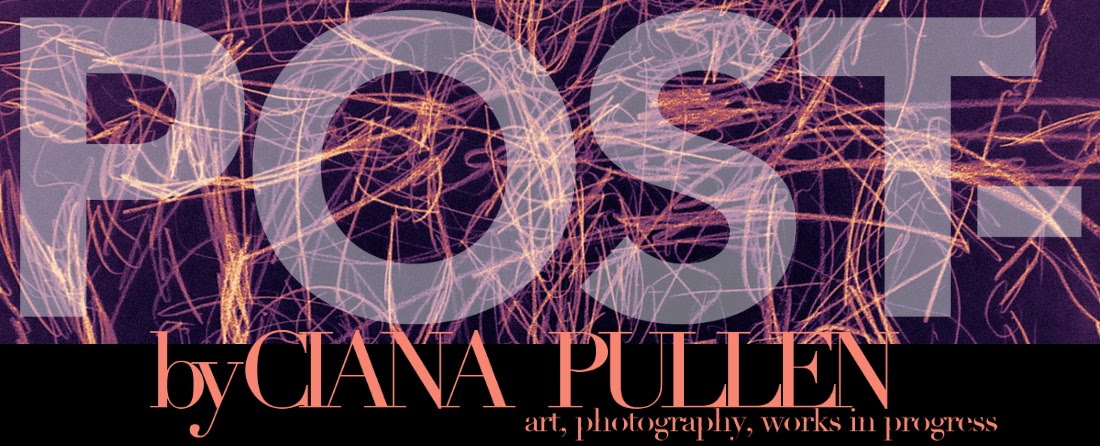Clement Greenberg, the famous '50s - '60s Modernist art critic, used to say that art should be judged and experienced virtually free of context, that it should stand on its own. You don't need to know about the artist or the scene.
I took a look at Alan W. Jackson's pen drawings at the City Gallery's "Under the Radar" exhibit, without any context besides the gallery atmosphere and here's what I saw. Just under ten abstract black & white line drawings on white paper framed in white behind glass. They were all based on simple patterns, drawn in the same size pen using lines only. Though they appeared very precise the hand execution allowed for subtle texture and undulations to appear. The finished pieces looked very polished and the titles simply described the pattern or method.

I thought the pieces might be engaging modernity, somehow related to digital love/hate. They reminded me of Agnes Martin's grid pieces but didn't seem to reflect any ethereal or spiritual qualities that defined those Martin pieces. Instead they seemed more bold, the hand-made variations dealing with clarity rather than uncertainty. The meaning, intention and even effect of the work was ambiguous.
As it turns out meeting Alan W. Jackson and hearing him speak about his work is a fantastic argument against Clement Greenberg's theory* of viewing artwork independently of the artist or context. Jackson, an architect and draftsman, explained that before the industry switched to auto-CAD everything was drawn by hand. First it was pencil on velum, then he switched to pen on mylar. Remarkably Jackson and his partner have re-imagined hand-rendered architectural drawing and still produce it professionally. Jackson showed many slides of the architectural drawings illustrating the very subtle differences in techniques; he didn't merely reference the idea of drafting, he wanted us to really look at the subtle differences, a quality that is reflected in his work.
Jackson then began doodling and that grew into free-association abstract line compositions. He showed the work to a friend in the art world and was encouraged to show it, and over time he developed the drawings hanging in the City Gallery.
He cited Eva Hesse and Sol LeWitt as inspiration. He appreciated Hesse's graphic abstractions more than any critical ideas associated with Hesse. LeWitt is famous for producing instructions to make a drawing then allowing others to create the works independently. Rather than capitalizing on the standard idea of LeWitt as a hands-off conceptual artist, however, Jackson connected with the idea of using simple instructions or a set of confines to complete a line drawing. One of Jackson's pieces, for example, is only broken vertical lines that cannot touch. Another is a series of sections of vertical lines each beginning with a wavy line and the rest reflecting that wave but gradually straightening out. Perhaps the ambiguity of his work has to do with similarities in appearance to such vastly different artists as Eva Hesse, Sol LeWitt and Agnes Martin.
Having heard Jackson speak the drawings now resembled a detailed plan or blueprint for a hand-knitted organic scarf or handwoven basket. Moreover the work and Jackson himself reminded me of a very difficult-to-describe type of curiosity that I associate with artists such as M.C. Escher, N. C. and Andy Wyeth (and the whole Wyeth family), and James Gurney, who illustrated Dinotopia and writes a fun blog about illustration. It's a science-y, empirical, experimental and myopic sort of curiosity. I generally run across this attitude in biographies or films that really depict how an artist works or views life and it is usually reflected in the sketchbooks, planning stages and odd side projects of the artists, i.e. the offshoot of a "serious" ouvre which reflects the craftsmanship side or underside of art-making.

Indeed drawing has long been associated with planning, not only in architecture but in old Academic traditions for both painters and sculptors. While daVinci's sketches and mock-ups may be priceless today such drawings were generally not valued as pieces unto themselves until the twentieth century. While the French Academie of the 1800s considered drawing more philosophical and painting itself to be associated with lowly craft and thus encouraged emphasis on tone and value over painterly color in a finished painting (according to Waldemar Januszczak in Techniques of the Great Masters of Art) the actual preliminary drawings were not themselves valued.
But by producing finished, polished pieces that begin and end with what's on the page (i.e. no reams of preliminary sketches but beginning with the instructions and ending with the finished drawing) Jackson has conflated the ends with the means. Even more interesting, his background in literally making plans has positioned the plan as the finished product. In this way he is similar to Sol LeWitt but in Jackson's case the plan itself is also an art object.
After hearing Jackson speak his work also brings to mind Piet Mondrian in that he has broken down visual expression into its very simplest elements--black lines on white paper--and is pushing the limits of what is possible in order to get the maximum expression from the simplest possible means. Mondrian was very involved in spiritual movements and was interested not only in pushing the simplest of formal elements to the visual max, but pushing visual representation itself beyond the physical realm and into the metaphysical. Jackson mentioned no such thing in his lecture but the pieces certainly are calmly awe-inspiring in terms of what is possible with the simplest broken line and a human mind.

*How ironic is it that a professional art critic would come up with the theory that a piece of art should stand alone without accompaniment? Way to write yourself out of existence.








